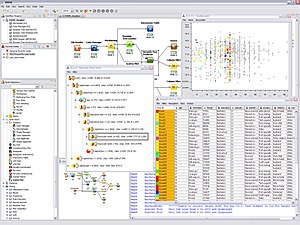KNIME
| KNIME
|
|
|---|---|

|
|
 Screenshot of KNIME |
|
| Basic data
|
|
| Current version | 4.2 (2020-07-13) |
| operating system | Linux , Macintosh , Windows |
| programming language | Java |
| category | Mathematics , statistics , bioinformatics , chemoinformatics |
| License | GPL ( Free Software ) |
| knime.org | |
KNIME , the “Konstanz Information Miner”, is free software for interactive data analysis . Thanks to its modular pipelining concept, KNIME enables the integration of numerous machine learning and data mining processes . The graphical user interface enables modules for data preprocessing ( ETL : Extraction, Transformation, Loading), modeling and analysis, and visualization to be combined quickly and easily . KNIME has been in use in pharmaceutical research since around 2006. KNIME is also used in other areas such as customer care (CRM), business intelligence and financial data analysis.
history
The development of KNIME began in the spring of 2004 - a group of software developers from Silicon Valley began designing the platform under the direction of Michael Berthold at the University of Konstanz . From the outset, the focus of development was on a professional software architecture that had to be scalable and highly modular. The first public version appeared in mid-2006, which, particularly in the pharmaceutical sector, quickly led to numerous commercial software providers also integrating their tools into KNIME. After the publication of an article in the c't in 2006, KNIME is also increasingly used in other areas. Since June 2008, a Zurich-based company (KNIME AG) has also made it possible to provide professional technical support and advisory services for the KNIME platform. KNIME scores above average in comparisons of open source data mining systems and stands out in particular for its user friendliness.
License
KNIME is available from version 2.1 under GPL .
Internals
KNIME is developed in Java and provided as an Eclipse plug-in. Other modules can easily be integrated as additional plugins. KNIME's core version contains several hundred modules for data integration (file I / O, database operators with support for all common databases), data transformations (filters, converters, combiners) as well as the most common methods of data analysis and visualization. Further properties of KNIME:
- KNIME's core architecture allows the processing of large amounts of data that are only limited by the available hard disk space (most other open source data analysis projects work memory-based and thus limit the amount of data that can be processed). Examples are the analysis of 300 million address data, 20 million cell images and 10 million molecular structures.
- Additional plugins allow the integration of methods for text mining and image mining as well as time series analysis.
- Integrations for numerous other open source processes exist, u. a. the methods of WEKA , the statistical R project as well as Lib SVM , JFreeChart and ImageJ .
Web links
Individual evidence
- ↑ The KNIME Open Source Project on Open Hub: Languages Page . In: Open Hub . (accessed October 18, 2018).
- ↑ Abhishek Tiwaria and Arvind KT Sekhar: Workflow based framework for life science informatics , Computational Biology and Chemistry, Volume 31, Issues 5–6, Pages 305–319, Elsevier, October 2007.
- ^ Treweren Consultants. Retrieved March 4, 2018 .
- ^ Chemical Computing Group. Retrieved March 4, 2018 .
- ↑ Selenium Nodes - Put your web browser to work with KNIME. Retrieved February 25, 2017 .
- ↑ Database mosaic data mining or the art of creating a picture from millions of data records, c't 20/2006, p. 164ff, Heise Verlag.
- ^ Forum on the KNIME website
- ↑ Xiaojun Chen, Yunming Ye, Graham Williams and Xiaofei Xu: A Survey of Open Source Data Mining Systems , Lecture Notes in Computer Science, vol. 4819, pp. 3–14, Springer-Verlag, 2009.